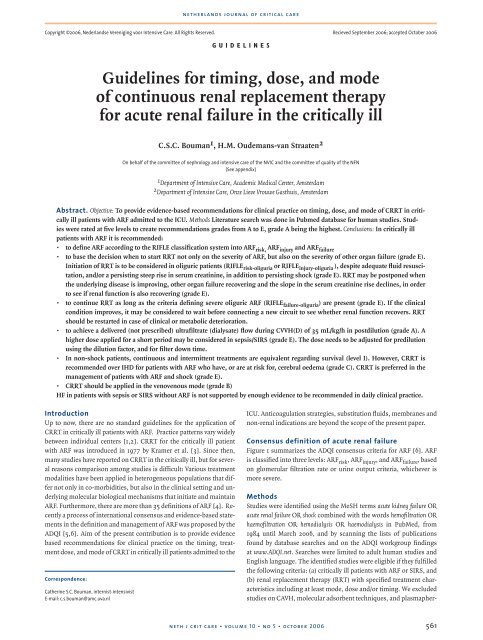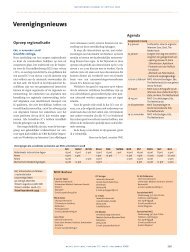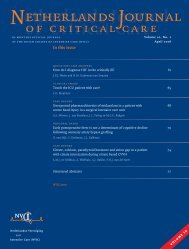netherlands journal of critical care 24. Murry,CE, Jennings,RB, Reimer,KA. Preconditioning with ischaemia : a delay of lethal cell injury in ischaemic myocardium. Circulation 1986;74:1124-1136. 25. Murry,CE, Richard,VJ, Jennings,RB, Reimer,KA. Myocardial protection is lost before contractile function recovers from ischaemic preconditioning. Am J Physiol 1991;260:H796-H804. 26. Marber,MS, Latchman,DS, Walker,JM, Yellon,DM. Cardiac stress protein elevation 24 hours after brief ischaemia or heat stress is associated with resistance to myocardial infarction. Circulation 1993;88:1264-1272. 27. Yellon,DM and Downey,JM. Preconditioning the myocardium: from cellular physiology to clinical cardiology. Physiol Rev 2003;83:1113-1151. 28. Zaugg,M and Schaub,MC. Signalling and cellular mechanisms in cardiac protection by ischaemic and pharmacological preconditioning. J Muscle Res Cell Motil 2003;24:219-249. 29. Garlid,KD, Dos,SP, Xie,ZJ, Costa,AD, Paucek,P. Mitochondrial potassium transport: the role of the mitochondrial ATP-sensitive K(+) channel in cardiac function and cardioprotection. Biochim Biophys Acta 2003;1606:1-21. 30. Bland,JH and Lowenstein,E. Halothane-induced decrease in experimental myocardial ischaemia in the non-failing canine heart. Anesthesiology 1976;45:287- 293. 31. Davis,RF, DeBoer,LW, Rude,RE, Lowenstein,E, Maroko,PR. The effect of halothane anaesthesia on myocardial necrosis, hemodynamic performance, and regional myocardial blood flow in dogs following coronary artery occlusion. Anesthesiology 1983;59:402-411. 32. De Hert,SG, Turani,F, Mathur,S, Stowe,DF. Cardioprotection with volatile anesthetics: mechanisms and clinical implications. Anesth Analg 2005;100:1584-1593. 33. Riess,ML, Stowe,DF, Warltier,DC. Cardiac pharmacological preconditioning with volatile anesthetics: from bench to bedside? Am J Physiol Heart Circ Physiol 2004;286:H1603-H1607. 34. Cope,DK, Impastato,WK, Cohen,MV, Downey,JM. Volatile anaesthetics protect the ischaemic rabbit myocardium from infarction. Anesthesiology 1997;86:699-709. 35. Toller,WG, Kersten,JR, Pagel,PS, Hettrick,DA, Warltier,DC. Sevoflurane reduces myocardial infarct size and decreases the time threshold for ischaemic preconditioning in dogs. Anesthesiology 1999;91:1437-1446. 36. Piriou,V, Chiari,P, Lhuillier,F, Bastien,O, Loufoua,J, Raisky,O, et al. Pharmacological preconditioning: comparison of desflurane, sevoflurane, isoflurane and halothane in rabbit myocardium{dagger}. Br J Anaesth 2002;89:486-491. 37. Varadarajan,SG, An,J, Novalija,E, Stowe,DF. Sevoflurane before or after ischaemia improves contractile and metabolic function while reducing myoplasmic Ca(2+) loading in intact hearts. Anesthesiology 2002;96:125- 133. 38. Tanaka,K, Ludwig,LM, Krolikowski,JG, Alcindor,D , Pratt,PF, Kersten,JR, et al. Isoflurane produces delayed preconditioning against myocardial ischaemia and reperfusion injury: role of cyclooxygenase-2. Anesthesiology 2004;100:525-531. 39. Preckel,B, Schlack,W, Comfere,T, Obal,D, Barthel,H, Thamer,V. Effects of enflurane, isoflurane, sevoflurane and desflurane on reperfusion injury after regional myocardial ischaemia in the rabbit heart in vivo. Br J Anaesth 1998;81:905-912. 40. Obal,D, Scharbatke,H, Barthel,H, Preckel,B, Mullenheim,J, Schlack,W. Cardioprotection against reperfusion injury is maximal with only two minutes of sevoflurane administration in rats: [La cardioprotection contre les lesions de reperfusion est maximale apres deux minutes seulement d’administration de sevoflurane chez des rats]. Can J of Anesth 2003;50:940-945. 41. Zhao,ZQ, Corvera,JS, Halkos,ME, Kerendi,F, Wang,NP, Guyton,RA, et al. Inhibition of myocardial injury by ischaemic postconditioning during reperfusion: comparison with ischaemic preconditioning. Am J Physiol Heart Circ Physiol 2003;285:H579-H588. 42. Yvon,A, Hanouz,JL, Haelewyn,B, Terrien,X, Massetti,M, Babatasi,G, et al. Mechanisms of sevoflurane-induced myocardial preconditioning in isolated human right atria in vitro. Anesthesiology 2003;99:27-33. 43. Ludwig,LM, Patel,HH, Gross,GJ, Kersten,JR, Pagel,PS, Warltier,DC. Morphine enhances pharmacological preconditioning by isoflurane: role of mitochondrial K(ATP) channels and opioid receptors. Anesthesiology 2003;98:705-711. 44. Hanouz,JL, Yvon,A, Massetti,M, Lepage,O, Babatasi,G, Khayat,A, et al. Mechanisms of desflurane-induced preconditioning in isolated human right atria in vitro. Anesthesiology 2002;97:33-41. 45. Zaugg,M, Lucchinetti,E, Spahn,DR, Pasch,T, Schaub,MC. Volatile Anaesthetics Mimic Cardiac Preconditioning by Priming the Activation of Mitochondrial KATP Channels via Multiple Signalling Pathways. Anesthesiology 2002;97:4-14. 46. Raphael,J, Rivo,J, Gozal,Y. Isoflurane-induced myocardial preconditioning is dependent on phosphatidylinositol- 3-kinase/Akt signalling. Br J Anaesth 2005;95:756-763. 47. Stadnicka,A, Kwok,WM, Warltier,DC, Bosnjak,ZJ. Protein tyrosine kinase-dependent modulation of isoflurane effects on cardiac sarcolemmal K(ATP) channel. Anesthesiology 2002;97:1198-1208. 48. Novalija,E, Varadarajan,SG, Camara,AKS, An,J, Chen,Q, Riess,ML, et al. Anesthetic preconditioning: triggering role of reactive oxygen and nitrogen species in isolated hearts. AJP - Heart and Circulatory Physiology 2002;283:H44-H52. 49. Becker,LB, Vanden Hoek,TL, Shao,ZH, Li,CQ, Schumacker,PT. Generation of superoxide in cardiomyocytes during ischaemia before reperfusion. Am J Physiol Heart Circ Physiol 1999;277:H2240-H2246. 50. Piper,HM, Abdallah,Y, Schafer,C. The first minutes of reperfusion: a window of opportunity for cardioprotection. Cardiovasc Res 2004;61:365-371. 51. Musters,RJ, van der Meulen,ET, Zuidwijk,M, Muller,A, Simonides,WS, Banerjee,A, et al. PKC-dependent preconditioning with norepinephrine protects sarcoplasmic reticulum function in rat trabeculae following metabolic inhibition. J Mol Cell Cardiol 1999;31 :1083- 1094. 52. An,J, Varadarajan,SG, Novalija,E, Stowe,DF. Ischaemic and anesthetic preconditioning reduces cytosolic [Ca2+] and improves Ca(2+) responses in intact hearts. Am J Physiol Heart Circ Physiol 2001;281:H1508-H1523. 53. Slogoff,S and Keats,AS. Randomized trial of primary anesthetic agents on outcome of coronary artery bypass operations. Anesthesiology 1989;70:179-188. 54. Roscoe,AK, Christensen,JD, Lynch,C, III. Isoflurane, but not halothane, induces protection of human myocardium via adenosine A1 receptors and adenosine triphosphate-sensitive potassium channels. Anesthesiology 2000;92:1692-1701. 55. Hassouna,A, Matata,BM, Galinanes,M. PKC-epsilon is upstream and PKC-alpha is downstream of mitoKATP channels in the signal transduction pathway of ischaemic preconditioning of human myocardium. Am J Physiol Cell Physiol 2004;287:C1418-C1425. 56. Speechly-Dick,ME, Grover,GJ, Yellon,DM. Does ischaemic preconditioning in the human involve protein kinase C and the ATP-dependent K+ channel? Studies of contractile function after simulated ischaemia in an atrial in vitro model. Circ Res 1995;77:1030-1035. 57. Ramsay,JG, DeLima,LG, Wynands,JE, O’Connor,JP, Ralley,FE, Robbins,GR. Pure opioid versus opioid-volatile anaesthesia for coronary artery bypass graft surgery: a prospective, randomized, double-blind study. Anesth Analg 1994;78:867-875. 58. Belhomme,D, Peynet,J, Louzy,M, Launay,JM, Kitakaze,M, Menasche,P. Evidence for preconditioning by isoflurane in coronary artery bypass graft surgery. Circulation 1999;100:II340-II344. 59. Pouzet,B, Lecharny,JB, Dehoux,M, Paquin,S, Kitakaze,M, Mantz,J, et al. Is there a place for preconditioning during cardiac operations in humans? Ann Thorac Surg 2002;73:843-848. 60. Penta,dP, Polisca,P, Tomai,F, De Paulis,R, Turani,F, Zupancich,E, et al. Recovery of LV contractility in man is enhanced by preischaemic administration of enflurane. Ann Thorac Surg 1999;68:112-118. 61. De Hert,SG, ten Broecke,PW, Mertens,E, van Sommeren,EW, de Blier,IG, Stockman,BA, et al. Sevoflurane but not propofol preserves myocardial function in coronary surgery patients. Anesthesiology 2002;97:42- 49. 62. De Hert,SG, Cromheecke,S, ten Broecke,PW, Mertens,E, de Blier,IG, Stockman,BA, et al. Effects of propofol, desflurane, and sevoflurane on recovery of myocardial function after coronary surgery in elderly high-risk patients. Anesthesiology 2003;99:314-323. 63. De Hert,SG, Van der Linden,PJ, Cromheecke,S, Meeus,R, ten Broecke,PW, de Blier,IG, et al. Choice of primary anesthetic regimen can influence intensive care unit length of stay after coronary surgery with cardiopulmonary bypass. Anesthesiology 2004;101:9-20. 64. De Hert,SG, Van der Linden,PJ, Cromheecke,S, Meeus,R, Nelis,A, Van,R, V, et al. Cardioprotective properties of sevoflurane in patients undergoing coronary surgery with cardiopulmonary bypass are related to the modalities of its administration. Anesthesiology 2004;101:299-310. 65. Julier,K, da Silva,R, Garcia,C, Bestman,L, Frascarolo,P, Zollinger,A, et al. Preconditioning by Sevoflurane Decreases Biochemical Markers for Myocardial and Renal Dysfunction in Coronary Artery Bypass Graft surgery: A Double-Blinded, Placebo-Controlled, Multicenter Study. Anesthesiology 2003;98:1315-1327. 66. Musters,RJ, van der Meulen,ET, van der Laarse,WJ, van Hardeveld,C. Norepinephrine pretreatment attenuates Ca2+ overloading in rat trabeculae during subsequent metabolic inhibition: improved contractile recovery via an alpha 1-adrenergic, PKC-dependent signalling mechanism. J Mol Cell Cardiol 1997;29:1341-1354. 67. Frassdorf,J, Weber,NC, Feindt,P, Borowski,A, Schlack,W. Sevoflurane- Induced Preconditioning: Evaluation of Two Different Protocols in Humans Undergoing Coronary Artery Bypass Grafting. Anesthesiology 2005;104: A338. 68. Kevin,LG, Novalija,E, Stowe,DF. Reactive oxygen species as mediators of cardiac injury and protection: the relevance to anaesthesia practice. Anesth Analg 2005;101:1275-1287. 69. El Azab,SR, Rosseel,PM, De Lange,JJ, Groeneveld,AB, van Strik,R, van Wijk,EM, et al. Effect of sevoflurane on the ex vivo secretion of TNF-alpha during and after coronary artery bypass surgery. Eur J Anaesthesiol 2003;20:380-384. 70. De Hert,SG. The concept of anaesthetic-induced cardioprotection: clinical relevance. Best Pract Res Clin Anaesthesiol 2005;19:445-459. 71. Bolli,R, Becker,L, Gross,G, Mentzer,R, Jr., Balshaw,D, Lathrop,DA. Myocardial protection at a crossroads: the need for translation into clinical therapy. Circ Res 2004;95:125-134. 72. Zhao,ZQ, Corvera,JS, Halkos,ME, Kerendi,F, Wang,NP, Guyton,RA, et al. Inhibition of myocardial injury by ischaemic postconditioning during reperfusion: comparison with ischaemic preconditioning. Am J Physiol Heart Circ Physiol 2003;285:H579. 73. Schlack,W, Preckel,B, Stunneck,D, Thamer,V. Effects of halothane, enflurane, isoflurane, sevoflurane and desflurane on myocardial reperfusion injury in the isolated rat heart. Br J Anaesth 1998;81:913-919. 74. Staat,P, Rioufol,G, Piot,C, Cottin,Y, Cung,TT, L’Huillier,I, et al. Postconditioning the human heart. Circulation 2005;112:2143-2148. 75. Ghosh,S, Standen,NB, Galinianes,M. Failure to precondition pathological human myocardium. J Am Coll Cardiol 2001;37:711-718. 76. Meiser A, Laubenthal H. Inhalational anaesthetics in the ICU: theory and practice of inhalational sedation in the ICU, economics, risk-benefit. Best Pract Res Clin Anaesth 2005;19(3):523-538. 560 neth j crit care • volume 10 • no 5 • october 2006
netherlands journal of critical care Copyright ©2006, Nederlandse Vereniging voor Intensive Care. All Rights Reserved. Recieved September 2006; accepted October 2006 Methods Studies were identified using the MeSH terms acute kidney failure OR acute renal failure OR shock combined with the words hemofiltration OR haemofiltration OR hemodialysis OR haemodialysis in PubMed, from 1984 until March 2006, and by scanning the lists of publications found by database searches and on the ADQI workgroup findings at www.ADQI.net. Searches were limited to adult human studies and English language. The identified studies were eligible if they fulfilled the following criteria: (a) critically ill patients with ARF or SIRS, and (b) renal replacement therapy (RRT) with specified treatment characteristics including at least mode, dose and/or timing. We excluded studies on CAVH, molecular adsorbent techniques, and plasmapherg u i d e l i n e s Guidelines for timing, dose, and mode of continuous renal replacement therapy for acute renal failure in the critically ill C.S.C. Bouman 1 , H.M. Oudemans-van Straaten 2 On behalf of the committee of nephrology and intensive care of the NVIC and the committee of quality of the NFN (See appendix) 1 Department of Intensive Care, Academic Medical Center, Amsterdam 2 Department of Intensive Care, Onze Lieve Vrouwe Gasthuis, Amsterdam Abstract. Objective: To provide evidence-based recommendations for clinical practice on timing, dose, and mode of CRRT in critically ill patients with ARF admitted to the ICU. Methods Literature search was done in Pubmed database for human studies. Studies were rated at five levels to create recommendations grades from A to E, grade A being the highest. Conclusions: In critically ill patients with ARF it is recommended: • to define ARF according to the RIFLE classification system into ARF risk, ARF injury and ARF failure • to base the decision when to start RRT not only on the severity of ARF, but also on the severity of other organ failure (grade E). Initiation of RRT is to be considered in oliguric patients (RIFLE risk-oliguria or RIFLE injury-oliguria ), despite adequate fluid resuscitation, and/or a persisting steep rise in serum creatinine, in addition to persisting shock (grade E). RRT may be postponed when the underlying disease is improving, other organ failure recovering and the slope in the serum creatinine rise declines, in order to see if renal function is also recovering (grade E). • to continue RRT as long as the criteria defining severe oliguric ARF (RIFLE failure-oliguria ) are present (grade E). If the clinical condition improves, it may be considered to wait before connecting a new circuit to see whether renal function recovers. RRT should be restarted in case of clinical or metabolic deterioration. • to achieve a delivered (not prescribed) ultrafiltrate (dialysate) flow during CVVH(D) of 35 mL/kg/h in postdilution (grade A). A higher dose applied for a short period may be considered in sepsis/SIRS (grade E). The dose needs to be adjusted for predilution using the dilution factor, and for filter down time. • In non-shock patients, continuous and intermittent treatments are equivalent regarding survival (level I). However, CRRT is recommended over IHD for patients with ARF who have, or are at risk for, cerebral oedema (grade C). CRRT is preferred in the management of patients with ARF and shock (grade E). • CRRT should be applied in the venovenous mode (grade B) HF in patients with sepsis or SIRS without ARF is not supported by enough evidence to be recommended in daily clinical practice. Introduction Up to now, there are no standard guidelines for the application of CRRT in critically ill patients with ARF. Practice patterns vary widely between individual centers [1,2]. CRRT for the critically ill patient with ARF was introduced in 1977 by Kramer et al. [3]. Since then, many studies have reported on CRRT in the critically ill, but for several reasons comparison among studies is difficult: Various treatment modalities have been applied in heterogeneous populations that differ not only in co-morbidities, but also in the clinical setting and underlying molecular biological mechanisms that initiate and maintain ARF. Furthermore, there are more than 35 definitions of ARF [4]. Recently a process of international consensus and evidence-based statements in the definition and management of ARF was proposed by the ADQI [5,6]. Aim of the present contribution is to provide evidence based recommendations for clinical practice on the timing, treatment dose, and mode of CRRT in critically ill patients admitted to the Correspondence: Catherine S.C. Bouman, internist-intensivist E-mail: c.s.bouman@amc.uva.nl ICU. Anticoagulation strategies, substitution fluids, membranes and non-renal indications are beyond the scope of the present paper. Consensus definition of acute renal failure Figure 1 summarizes the ADQI consensus criteria for ARF [6]. ARF is classified into three levels: ARF risk , ARF injury , and ARF failure , based on glomerular filtration rate or urine output criteria, whichever is more severe. neth j crit care • volume 10 • no 5 • october 2006 561







